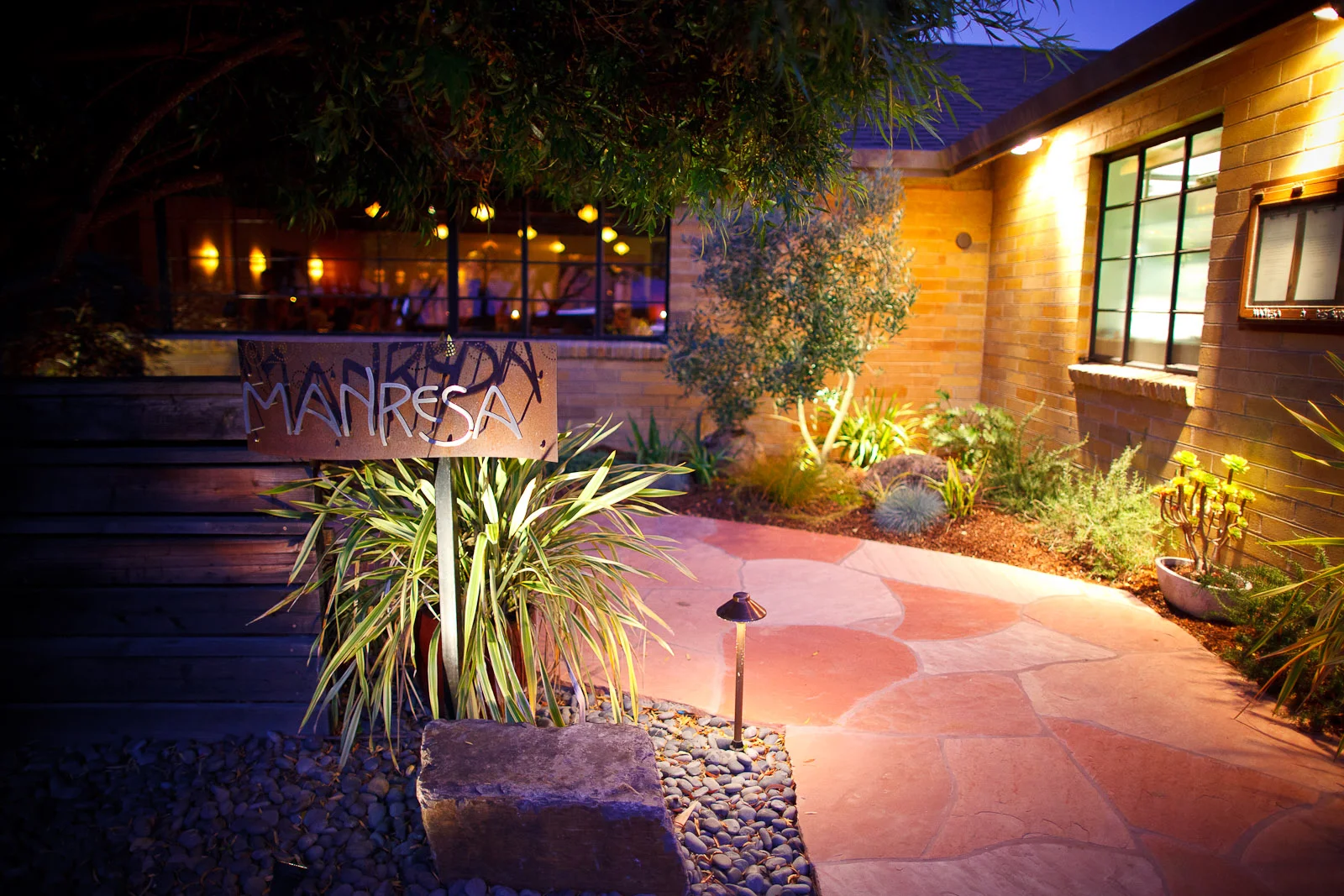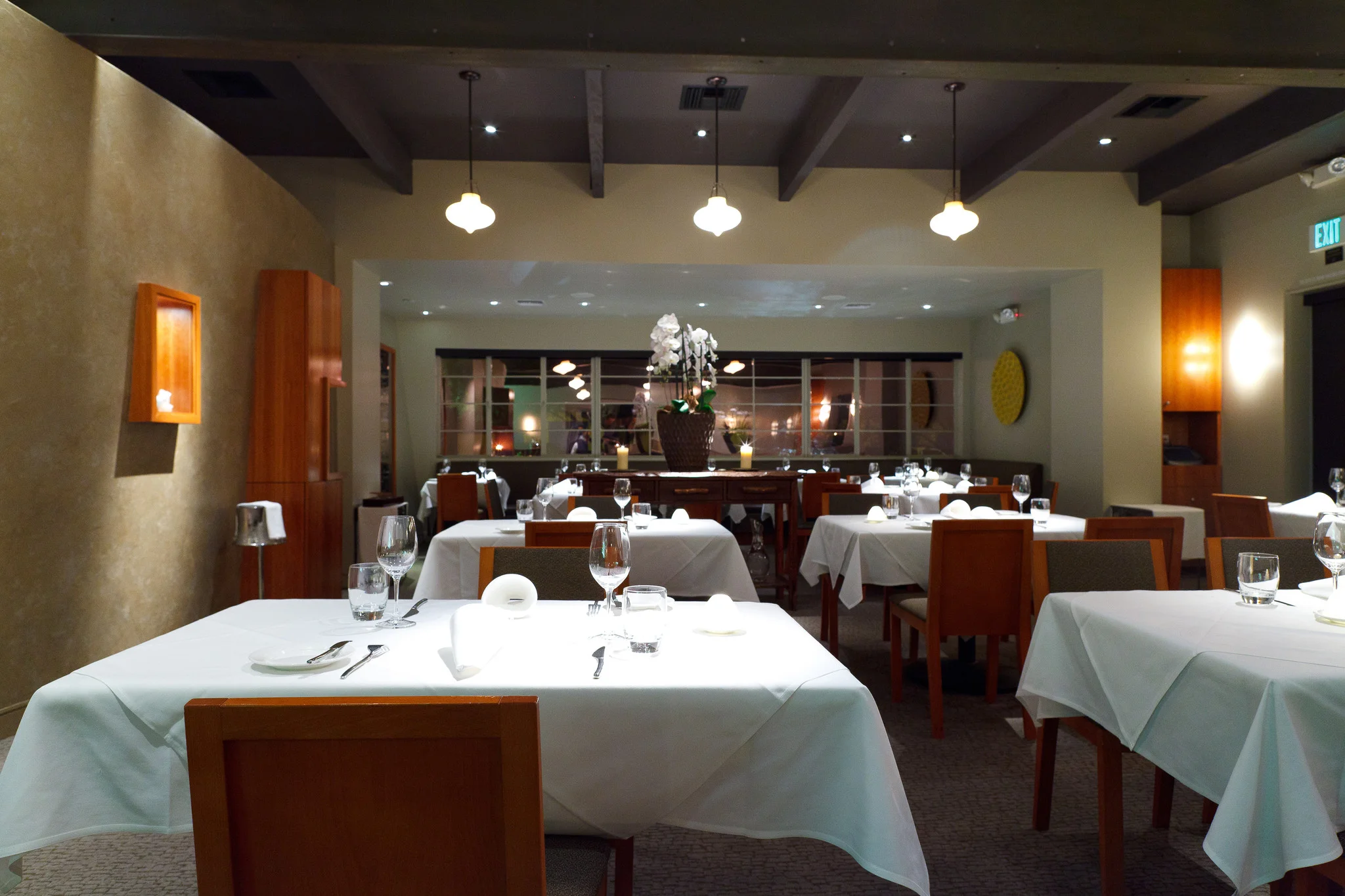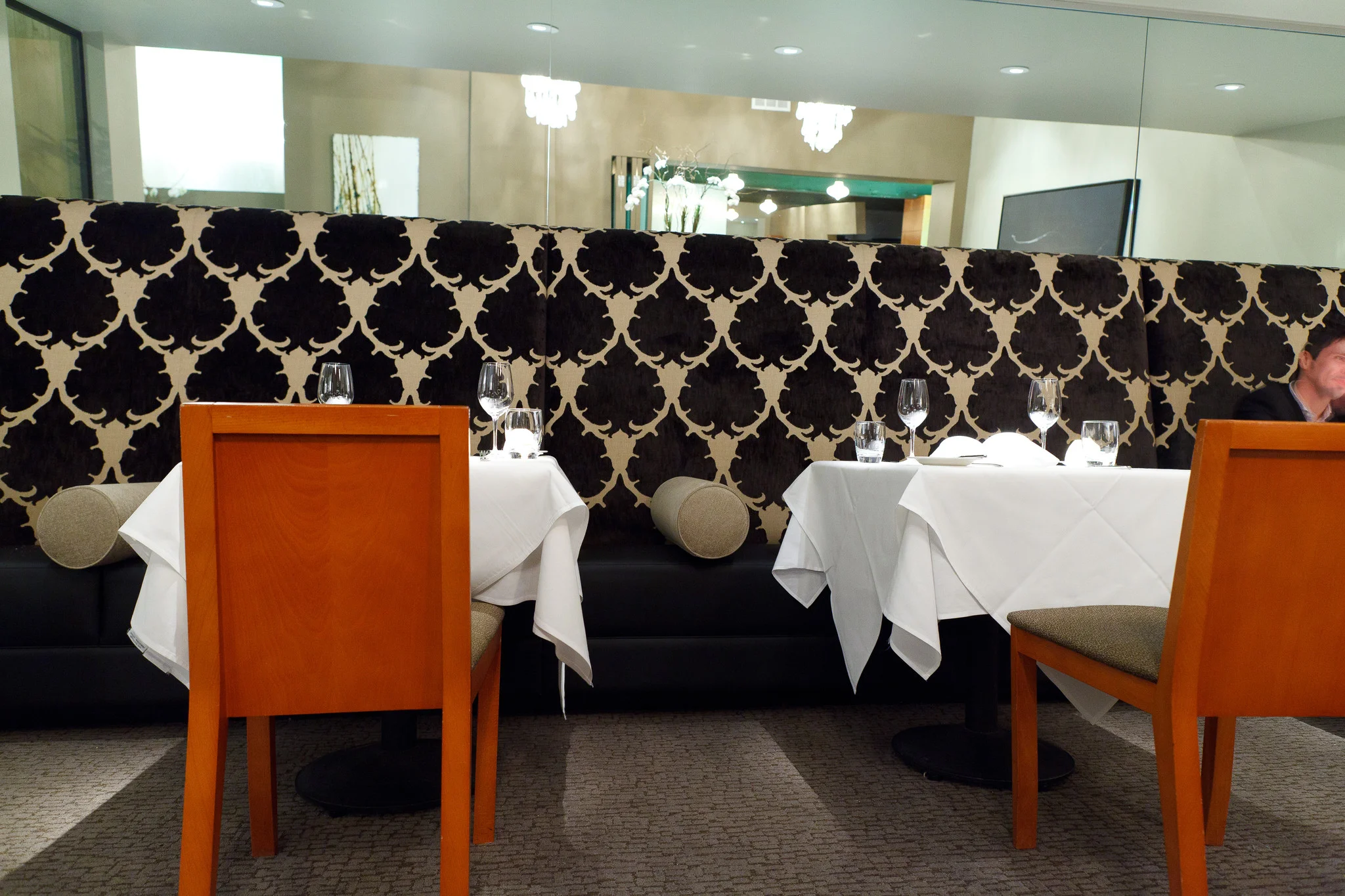Manresa
I first visited Manresa in Los Gatos, California, during the spring of 2006. I was immediately intrigued by chef David Kinch's cooking. This is a chef with a near perfect understanding of his restaurant's time and place, one who truly utilizes the local ingredients of the bay area; Manresa would not work if located elsewhere. Chef Kinch has a masterful understanding of when to enhance an ingredient's flavor through cooking, and when to step back and let nature speak for itself. I have since been back half a dozen times, each time a completely different menu and experience. Each meal has been progressively better. The ever evolving cuisine reveals a chef with tremendous versatility, precision, and passion. For these reasons, I believe Chef Kinch is currently the best chef in America.
In person, chef Kinch is soft-spoken and humble, rarely talking about himself or his current inspirations. The best way to understand chef Kinch is to understand his food. This is what makes each visit to Manresa special: each meal is a speechless conversation with chef Kinch, and he has a lot to say. During my first few visits, his food spoke of recent trips to France, revealing inspiration from Alain Passard and Michel Bras. He returned obsessed with vegetables, forging a partnership with Cynthia Sandberg of Love Apple Farms. More recently, his food spoke of visits to Tokyo and Kyoto: walks through tsukiji market and kaiseki meals at Koju. While chef Kinch's cooking is enjoyed by everyone, it speaks even louder to diners who have eaten in Paris and Tokyo. David Kinch is a foodie's chef.
One of the things I most admire about chef Kinch is his disregard for culinary politicking. Like Quique Dacosta of Spain, his cooking style reflects his current passions, regardless of what's en vogue. Noma's ascension to the top of Pellegrino's best restaurants list has not affected Kinch's food in the slightest. This is a breath of fresh air. He's a no-nonsense culinary rebel.
Manresa, named after the small Spanish north west of Barcelona, is about an hour south of San Francisco. A winding path leads from a quiet street to the restaurant. After passing the reception desk, the newly added modern dining room hangs left while the original dining room remains off to the right.
Amuse bouche - Black olive madeleines and roasted bell pepper pâtes de fruits
Black olive madeleines and roasted bell pepper pâtes de fruits - Our meal started with a Manresa staple, a cake-like madeline of black olive and a sugar-coated jelly of roasted red bell pepper. These two vegetal snacks, disguised as sweets, hint at the restaurant's deep connection to local produce. It's hard to describe these as delicious, but there is an addictive quality to them.
1st Course - Roquefort cheese sablé
Roquefort cheese sablé - A crispy, salty, cheesy snack that really complimented the crisp green apple from our champagne.
Paired with N.V. Diebolt-Vallois Champagne Blanc de Blanc Brut à Cramant
Garden beignets, crispy kale, vinegar powder
Garden beignets, crispy kale, vinegar powder - Warm beignets counterbalanced with the subtle acidity of the vinegar powder. The crispy kale added a vegetal bitterness. This was a small arrangement of textures all held together by the leafy green taste of the garden.
3rd Course - "An elemental oyster" - Lightly poached in its own shell, ocean water gelée, nori flakes
An elemental oyster - A local oyster lightly poached in its own shell, topped with an ocean water gelée, and a sprinkle of nori flakes. The oyster was impeccably fresh -- sweet and briny -- and the subtle poaching enhance the oyster's natural sweetness. The ocean water gelée extended the texture of the oyster making it taste twice the size. The umami of the dried seaweed enhanced the shellfish's natural flavors.
Paired with Hangar One Kaffir Lime Vodka
This pairing with the vodka was too intense for me. While the vodka did have a clean taste and a pleasant citrus component from the kaffir lime, the burn of the alcohol distracted from the delicate flavors of the oyster.
4th Course - Pig leaf curd, coriander granita, marcona almond, strawberry gazpacho
Fig leaf curd, coriander granita, marcona almond, strawberry gazpacho - Wow. This was summer in a bowl. A rich lather of chilled strawberry gazpacho was poured into an herbal, ice cold coriander granita. This was an exceptionally fragrant and balanced dish highlighting the fresh produce of late summer.
5th Course - Japanese sardines with beets, watermelon, radish and a garden sorrel sauce
Japanese sardines with beets, watermelon, radish, and a garden sorrel sauce - A small sardine carried by the fresh vegetal bitterness of the chilled sorrel sauce. The sweet chunks of compressed watermelon and beets added a hint of sugar to an otherwise savory dish. This was a minimalist dish exemplifying how the freshness of raw vegetables can enhance the freshness of the sea. A simple dish with little cooking, where chef Kinch took a step back and let the natural ingredients speak for themselves.
6th Course - Raw milk panna cotta, Monterey bay abalone and an abalone dashi gelée
Raw milk panna cotta, Monterey bay abalone and an abalone-dashi gelée - This was an exceptional dish, one that demonstrated chef Kinch's deep understanding of Japanese cuisine and simplicity, and how to apply those techniques with local ingredients. With a texture like chawanmushi, room temperature raw-milk panna cotta formed the base of this dish. The panna cotta was covered with a thin layer of transparent abalone gelée. The gelée was delicately salted and dotted with chunks of warm, meaty abalone. This was one of the most memorable dishes I've tasted this year.
7th Course - Albacore tuna, runner beans, crispy bean shell bouillon, lemon verbena, olive oil
Albacore tuna, runner beans, crispy bean shell bouillon, lemon verbena, olive oil - This was chef Kinch's sashimi course in a traditional kaiseki sequence. The tuna was lean but still buttery with an herbal note that grounded the dish to California.
8th Course - Razor clams with wild rice, chrysanthemum and roast chicken gelée, fennel fronds
Razor clams - A small bowl of razor clams with wild rice, chrysanthemum and roast chicken gelée, topped with fennel fronds. This was another incredible dish. Chewy, plump grains of wild rice topped with chunks of razor clam whose meaty flavor was enhanced by the roast chicken gelée. The chrysanthemum and fennel fronds added an anise-like herbal dimension that kept each bite interesting. This was a dish that took me back to the rice courses from some of my favorite kaiseki experiences in Japan.
Paired with a 2007 Izadi Viura from Rioja
9th Course - "A Summer Tidal Pool" - Monterrey bay abalone, sea urchin, foie gras, local spot prawns, hinoki mushroom in a dashi broth
A summer tidal pool - A David Kinch classic, a dish that has taken on various forms over the years. This was the best version yet. Chunks of Monterey bay abalone, sea urchin, foie gras, local spot prawn, and hinoki mushroom swimming in a beautifully salted dashi broth. It was as if chef Kinch took a list of my favorite Japanese ingredients and combined them into one dish. This was a simple dish with a very complex flavor; sweet sea urchin and prawns, buttery foie gras, meaty abalone and earthy hinoki combined into a broth of absolute perfection. This is a dish where chef Kinch exercised culinary restraint, letting a simple dashi broth serve as the clean canvas for the natural flavors of the sea.
Paired with a 2009 COS Rami 50% insolio and 50% grecanico from Sicily IGT
10th Course - "Into the vegetable garden…" - A showcase of vegetables hand picked this morning at Love Apple Farms
Into the vegetable garden - A handpicked showcase of the day's herbs from Love Apple Farms combined into a beautiful, colorful potpourri. I loved this dish and Kinch's local interpretation of the gargouillou. This dish was a collection of textures both smooth and crunchy and herbal flavors ranging from sweet to bitter. My only complaint is that it's a bit awkward to eat these delicate, almost weightless leaves with a full-sized fork and knife; it would have been easier with a pair of fine chopsticks or culinary forceps. This is a dish that connects Manresa to its surroundings, a reminder that California has the finest produce in the country.
Paired with a 2010 Domaine du Salvard Sauvignon Blanc from Cheverny
The meal could have ended right here and it would have been one of my all time favorite dining experiences. The last seven dishes made one of the best sequences in a restaurant I've ever had. What came was still outstanding, but of a very different foundation from the first half of the meal. The meal took a turn from Japan and headed back to Europe.
11th Course - Late season fava beans made into a "risotto," farm egg, morel mushroom, sheep's milk ricotta
Late season fava beans - A risotto made from late season fava beans with a farm egg, morel mushrooms, and sheep's milk ricotta. This was a very original, creative dish where the chewy fava beans were cooked to mimic the texture of risotto. The butter and generous salting carried this dish, enhancing the earthiness of the mushrooms. The ricotta thickened the sauce making it really texturally close to a risotto.
Paired with a 2009 Bruno Clair Rosé of Pinot Noir from Marsanny
12th Course - Monterey bay abalone cooked in brown butter, pesto of pickled cucumber and walnut, Malabar spinach
Monterey bay abalone - A firm medallion of abalone cooked in brown butter topped table-side with a pesto of pickled cucumber and walnut. A few leaves of Malabar spinach added a vegetal, tannic component to the dish. The butter really helped bring out the flavor of the abalone, and the pickled cucumber pesto brightened the meatiness of the shellfish.
13th Course - Poached halibut served with with young celeriac, romanesco
Poached halibut - Thick cuts of poached halibut served with thinly sliced young celeriac and romanesco. This was one of my least favorite courses of the night. There was nothing particularly wrong with the dish, but after a heavenly sequence of abalone, razor clams, sea urchin, spot prawn, and foie gras, giant chunks of poached halibut seemed boring. This would have been a great dish as part of a smaller tasting menu, but at this point in the sequence, it didn't make much sense.
Paired with a 2006 Domaine de la Tournelle Terre de Gryphees Chardonnay from Arbois, France
14th Course - Suckling porcelet, chanterelle mushrooms, apricots and anise purée, courgette velouté, pistachio pesto
Suckling porcelet - A generous cut of young pig served with chanterelle mushrooms, apricot-anise purée, courgette velouté, and a pistachio pesto. This was a heavier course and although fatty, the crispy skin really helped diversify the texture; the crunch was the best part of this dish.
Paired with a 2007 Jacques Puffeney Trousseau from Arbois France
15th Course - Potatoes-duck fat "paillasson," fennel and turnip, bitter orange with olive
Potatoes and duck fat "paillasson" - A crispy hash of potatoes cooked in duck fat, garnished with fennel and turnip. There were also small drops of bitter orange and olive. This was a very balanced dish with almost no oily mouthfeel, despite having been fried in duck fat.
Paired with a 2008 Domaine Maume from Gevrey-Chambertin
16th Course - Summer berries, roasted and raw, lemon cream with açaí granite, yogurt sorbet
Summer berries and cream - Summer berries, both roasted and raw with a lemon cream. Underneath the berries was a bed of açaí granite and yogurt sorbet. This was light and sweet with the cream sauce giving the dish some substance, but the lemon ensuring it tasted bright and refreshing.
Paired with a 2008 Pride Mountain Cabernet Franc from Sonoma County
17th Course - Chocolate caramel cremeaux, fleur de sel ice cream, popcorn custard
Chocolate-caramel cremeaux - Dollops of chocolate-caramel cream with fleur de sel ice cream and a popcorn custard. I really don't like chocolate-flavored desserts (I love pure chocolate) but this was pretty good. Mainly because there wasn't much bitterness in the chocolate, and the popcorn added a buttery, nutty component that made this really interesting.
Paired with a 2009 Earl Champalou Les Tries de Champalou Chenin Blanc from Vouvray
Cheese course - Bent river, blond d'espèce, Pleasant Ridge reserve, Amarello de beta spacious, Garden Variety's Moonflower, Gabriel Coulet Roquefort, Redwood Hill's Bucheret, Chèvriere cendre, Cypress grove Midnight moon
The cheese cart - Bent river, Blond d'Espèce, Pleasant Ridge reserve, Amarello de beta spacious, Garden Variety's Moonflower, Gabriel Coulet Roquefort, Redwood Hill's Bucheret, Chèvriere Cendre, and Cypress Grove Midnight Moon.
Cheese course - Roquefort, Chevrière cendre (concord grape ash), Gouda-style Midnight moon, Cow's milk Pleasant ridge reserve, Bent River
We chose a few pieces from the cart: Roquefort, Chevrière cendre (concord grape ash), Gouda-style Midnight moon, Cow's milk Pleasant ridge reserve, and Bent River.
Wall of wine
By this point in the meal, we were left with a gorgeous gradient of wines.
Petits fours - strawberry pâtes de fruits, chocolate madeleines
Petits fours - Strawberry pâtes de fruits and chocolate madeleines. We finished the meal much in the same way we started, only with fruit instead of vegetables.
I loved my recent meal at Manresa. The cooking was consistently flawless, and the flavors balanced and delicious. While this was an incredible tasting, the meal really felt like two tastings in a single sitting, one of Japan and one of France and Spain. I'm tempted to return to try the shorter menu next time in hopes that it could be even more focused.
The overall experience was refined and comfortable: this restaurant has really transitioned from a local, neighborhood place to one that deserves a lot more international attention than it's currently receiving. The restaurant currently has two Michelin stars, but if this isn't a three star restaurant at this point, I'm not sure what is. In the meantime now is the perfect time to go; I have a funny suspicion the restaurant is about to get a lot busier.










